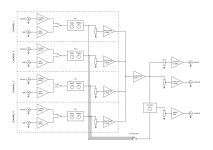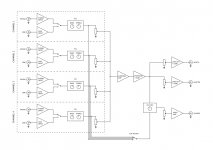I am trying to design a simple 4-channel DJ mixer using circuits from Douglas Self's Small Signal Audio Design exclusively. There are some extensive mixer architecture diagrams in that book that are very useful but much more complicated than what I am trying to make. In those diagrams one can see some "postfade amplifiers", such that the faders can provide some gain, usually up to +10dB. Attached are 2 diagrams I came up with for my system, the difference being the position of the postfade amp. The first diagram presents one postfade amp in each channel module, similar to what a traditional mixer would do according to the book. However, since the overall architecture is much simpler, I notice I can move the postfade amps down the signal path, namely after summing the channel outputs. Doing this would save me quite some components. Is there any reason why I shouldn't do this?
Attachments
Hi,
Usually there is no make up gain on mixer faders i've seen, but there is 10db gain availlable in the summing bus amplifiers and the labeling on chanel fader tell 0db ( Unity Gain) when it is in reality attenuating of 10db...
There is two main ways to configure a typical mixer either passive or active ( virtual ground/acn).
Here is a document about both ways and what they implies:
https://www.google.com/url?sa=t&sou...8QFnoECA8QAQ&usg=AOvVaw0eZ9foZULcZVIq5aImaqTN
Usually there is no make up gain on mixer faders i've seen, but there is 10db gain availlable in the summing bus amplifiers and the labeling on chanel fader tell 0db ( Unity Gain) when it is in reality attenuating of 10db...
There is two main ways to configure a typical mixer either passive or active ( virtual ground/acn).
Here is a document about both ways and what they implies:
https://www.google.com/url?sa=t&sou...8QFnoECA8QAQ&usg=AOvVaw0eZ9foZULcZVIq5aImaqTN
Op option 2 misses the point of the 10dB gain postfade amplifier , on my mixer the faders are marked with +10 as maximum with 0dB marked a reasonable distance below that . The reasoning is you set up a mix with most faders at or below the 0dB mark then should you need to increase the level of a single channel you have 10dB in reserve and you don't have to adjust all the other channels down and yes the postfade amplifiers have 10dB of gain and they also serve to buffer the fader from the pan and aux pots . In your case you could probably do away with the postfade amplfier/s altogether if you don't need its gain but you need to bear in mind what I have already written and set your levels up without the faders maxed out . Watch out for the levels going into the line inputs if for example they are being fed from CD players then you will most likely need attenuation not amplification to give a balance with the phono levels .
Mixing is a lossy process; thus prone to hiss.
Running the fader to the mix-network is loss after loss.
Are decent mix-amps that awkward? I remember salvaging a Langevin used in mobile TV broadcasts that was hundreds of pounds of standardized booster amps.
Running the fader to the mix-network is loss after loss.
Are decent mix-amps that awkward? I remember salvaging a Langevin used in mobile TV broadcasts that was hundreds of pounds of standardized booster amps.
Thank you all for your answers.
However, the way I see it, both circuits are equivalent. Summing is a linear operation, so amplifying by a fixed +10dB before or after summing should be the same!
That's precisely why I want postfade amplifiers. I want the 0dB point to be a bit before the maxed-out position, such that a new coming track can be amplified if needed instead of attenuating all the other channels. As you mention I can achieve that without using any postfade amps, but then I would be attenuating all the channels most of the time.Op option 2 misses the point of the 10dB gain postfade amplifier , on my mixer the faders are marked with +10 as maximum with 0dB marked a reasonable distance below that . The reasoning is you set up a mix with most faders at or below the 0dB mark then should you need to increase the level of a single channel you have 10dB in reserve and you don't have to adjust all the other channels down and yes the postfade amplifiers have 10dB of gain and they also serve to buffer the fader from the pan and aux pots . In your case you could probably do away with the postfade amplfier/s altogether if you don't need its gain but you need to bear in mind what I have already written and set your levels up without the faders maxed out . Watch out for the levels going into the line inputs if for example they are being fed from CD players then you will most likely need attenuation not amplification to give a balance with the phono levels .
However, the way I see it, both circuits are equivalent. Summing is a linear operation, so amplifying by a fixed +10dB before or after summing should be the same!
😳 apologies my mistake , its mainly about not maxing out the fader on initial mix although there might be a slight increase in noise as you would be mixing with a lower level signal with option 2 .However, the way I see it, both circuits are equivalent. Summing is a linear operation, so amplifying by a fixed +10dB before or after summing should be the same!
True on paper. In real life, everything is "plus hiss".Summing is a linear operation, so amplifying by a fixed +10dB before or after summing should be the same!
A proper level diagram has the hiss graphed. But this is a lost art.
Steve Dove's writing in Handbook for Sound Engineers is appropriate.
I am trying to design a simple 4-channel DJ mixer using circuits from Douglas Self's Small Signal Audio Design exclusively. There are some extensive mixer architecture diagrams in that book that are very useful but much more complicated than what I am trying to make. In those diagrams one can see some "postfade amplifiers", such that the faders can provide some gain, usually up to +10dB. Attached are 2 diagrams I came up with for my system, the difference being the position of the postfade amp. The first diagram presents one postfade amp in each channel module, similar to what a traditional mixer would do according to the book. However, since the overall architecture is much simpler, I notice I can move the postfade amps down the signal path, namely after summing the channel outputs. Doing this would save me quite some components. Is there any reason why I shouldn't do this?
Those diagrams look nice. What software did you use to create them, if you don't mind me asking?
- Home
- Source & Line
- Analog Line Level
- Mixer architecture and postfade amps

